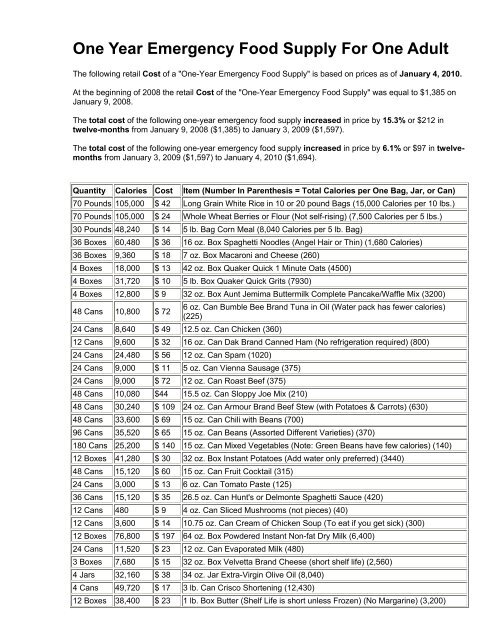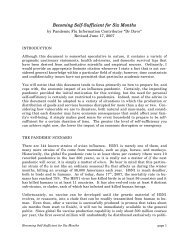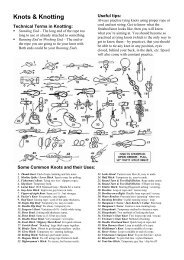One Year Emergency Food Supply For One Adult - Blog by Survival ...
One Year Emergency Food Supply For One Adult - Blog by Survival ...
One Year Emergency Food Supply For One Adult - Blog by Survival ...
Create successful ePaper yourself
Turn your PDF publications into a flip-book with our unique Google optimized e-Paper software.
<strong>One</strong> <strong>Year</strong> <strong>Emergency</strong> <strong>Food</strong> <strong>Supply</strong> <strong>For</strong> <strong>One</strong> <strong>Adult</strong><br />
The following retail Cost of a "<strong>One</strong>-<strong>Year</strong> <strong>Emergency</strong> <strong>Food</strong> <strong>Supply</strong>" is based on prices as of January 4, 2010.<br />
At the beginning of 2008 the retail Cost of the "<strong>One</strong>-<strong>Year</strong> <strong>Emergency</strong> <strong>Food</strong> <strong>Supply</strong>" was equal to $1,385 on<br />
January 9, 2008.<br />
The total cost of the following one-year emergency food supply increased in price <strong>by</strong> 15.3% or $212 in<br />
twelve-months from January 9, 2008 ($1,385) to January 3, 2009 ($1,597).<br />
The total cost of the following one-year emergency food supply increased in price <strong>by</strong> 6.1% or $97 in twelvemonths<br />
from January 3, 2009 ($1,597) to January 4, 2010 ($1,694).<br />
Quantity Calories Cost Item (Number In Parenthesis = Total Calories per <strong>One</strong> Bag, Jar, or Can)<br />
70 Pounds 105,000 $ 42 Long Grain White Rice in 10 or 20 pound Bags (15,000 Calories per 10 lbs.)<br />
70 Pounds 105,000 $ 24 Whole Wheat Berries or Flour (Not self-rising) (7,500 Calories per 5 lbs.)<br />
30 Pounds 48,240 $ 14 5 lb. Bag Corn Meal (8,040 Calories per 5 lb. Bag)<br />
36 Boxes 60,480 $ 36 16 oz. Box Spaghetti Noodles (Angel Hair or Thin) (1,680 Calories)<br />
36 Boxes 9,360 $ 18 7 oz. Box Macaroni and Cheese (260)<br />
4 Boxes 18,000 $ 13 42 oz. Box Quaker Quick 1 Minute Oats (4500)<br />
4 Boxes 31,720 $ 10 5 lb. Box Quaker Quick Grits (7930)<br />
4 Boxes 12,800 $ 9 32 oz. Box Aunt Jemima Buttermilk Complete Pancake/Waffle Mix (3200)<br />
48 Cans 10,800 $ 72<br />
6 oz. Can Bumble Bee Brand Tuna in Oil (Water pack has fewer calories)<br />
(225)<br />
24 Cans 8,640 $ 49 12.5 oz. Can Chicken (360)<br />
12 Cans 9,600 $ 32 16 oz. Can Dak Brand Canned Ham (No refrigeration required) (800)<br />
24 Cans 24,480 $ 56 12 oz. Can Spam (1020)<br />
24 Cans 9,000 $ 11 5 oz. Can Vienna Sausage (375)<br />
24 Cans 9,000 $ 72 12 oz. Can Roast Beef (375)<br />
48 Cans 10,080 $44 15.5 oz. Can Sloppy Joe Mix (210)<br />
48 Cans 30,240 $ 109 24 oz. Can Armour Brand Beef Stew (with Potatoes & Carrots) (630)<br />
48 Cans 33,600 $ 69 15 oz. Can Chili with Beans (700)<br />
96 Cans 35,520 $ 65 15 oz. Can Beans (Assorted Different Varieties) (370)<br />
180 Cans 25,200 $ 140 15 oz. Can Mixed Vegetables (Note: Green Beans have few calories) (140)<br />
12 Boxes 41,280 $ 30 32 oz. Box Instant Potatoes (Add water only preferred) (3440)<br />
48 Cans 15,120 $ 60 15 oz. Can Fruit Cocktail (315)<br />
24 Cans 3,000 $ 13 6 oz. Can Tomato Paste (125)<br />
36 Cans 15,120 $ 35 26.5 oz. Can Hunt's or Delmonte Spaghetti Sauce (420)<br />
12 Cans 480 $ 9 4 oz. Can Sliced Mushrooms (not pieces) (40)<br />
12 Cans 3,600 $ 14 10.75 oz. Can Cream of Chicken Soup (To eat if you get sick) (300)<br />
12 Boxes 76,800 $ 197 64 oz. Box Powdered Instant Non-fat Dry Milk (6,400)<br />
24 Cans 11,520 $ 23 12 oz. Can Evaporated Milk (480)<br />
3 Boxes 7,680 $ 15 32 oz. Box Velvetta Brand Cheese (short shelf life) (2,560)<br />
4 Jars 32,160 $ 38 34 oz. Jar Extra-Virgin Olive Oil (8,040)<br />
4 Cans 49,720 $ 17 3 lb. Can Crisco Shortening (12,430)<br />
12 Boxes 38,400 $ 23 1 lb. Box Butter (Shelf Life is short unless Frozen) (No Margarine) (3,200)
12 Cans 10,800 $ 36 8 oz. Container Hershey's Cocoa Powder (900)<br />
8 Cans 9,600 $ 13 16 oz. Can Hershey's Cocoa Syrup (1200)<br />
6 Boxes 10,080 $ 6 16 oz. Box Corn Starch (1,680)<br />
25 Pounds 42,500 $ 15 5 lb. Bag White Granulated Sugar (8,500)<br />
12 Pounds 10,200 $ 11 1 lb. Box Light Brown or Dark Brown Sugar (1,700)<br />
12 Pounds 10,800 $ 11 1 lb. Box Confectioners Sugar (1,800)<br />
12 Boxes 26,400 $ 17 20 oz. Box Brownie Mix (or Cake Mix) (2,200)<br />
6 Jars 11,520 $ 9 18 oz. Jar Light Corn Syrup (1,920)<br />
6 Bottles 21,600 $ 15 36 oz. Bottle Log Cabin Syrup (3,600)<br />
6 Jars 10,240 $ 42 24 oz. Jar "Sue Bee Brand" Clover Honey (1,920)<br />
12 Jars 36,480 $ 24 18 oz. Jar Peanut Butter (3,040)<br />
12 Jars 15,600 $ 13 16 oz. Jar Jelly or Preserves (1,300)<br />
24 Pkgs. 0 $ 12 5/16 oz. Package Hodgson Mill Brand Yeast (Store in Ziplock in Freezer)<br />
12 Cans 0 $ 14 10 oz. Can Baking Powder (Store in Ziplock Bag in Refrigerator or Freezer)<br />
12 Boxes 0 $ 6 16 oz. Box Baking Soda<br />
6 Bottles 0 $ 27 2 oz. Bottle Vanilla Extract<br />
48 Each 0 $ 12 Beef Bouillon Cubes<br />
48 Each 0 $ 12 Chicken Bouillon Cubes<br />
24 Pounds 0 $ 7 4 lb. Box Salt (Morton Brand Canning and Pickling Salt) (Pure Salt)<br />
12 Jars 0 $ 12 2.6 oz. Ground Black Pepper (or Whole Peppercorns) (Walmart)<br />
12 Jars 0 $ 6 3.12 oz. Onion Powder (Walmart)<br />
2 Jars 0 $ 1 0.9 oz. Oregano (Walmart)<br />
2 Jars 0 $ 1 2.5 oz. Garlic Powder (Walmart)<br />
2 Jars 0 $ 1 2.37 oz. Cinnamon (Walmart)<br />
1 Jar 0 $ 1 0.4 oz. Parsley Flakes (Walmart)<br />
1 Jar 0 $ 4 1.75 oz. Cayenne Red Pepper<br />
2 Jars 0 $ 9 2.62 oz. Cream of Tartar<br />
2 Bottles 0 $ 4 15 oz. Bottle Lemon Juice (Short shelf life)<br />
1 Jug 0 $ 3 1 Gallon Jug Apple Cider Vinegar<br />
------ ------ ------ ------<br />
Totals = 1,108,740 $1,694 <strong>One</strong>-<strong>Year</strong> <strong>Emergency</strong> <strong>Food</strong> <strong>Supply</strong> for <strong>One</strong> <strong>Adult</strong><br />
Comfort <strong>Food</strong>s: The above list contains 60 different food items. However, you should also purchase some<br />
Kool-Aid, Tang, Coffee, Tea, Soft Drinks, Beer, Wine, Miniature Tootsie Rolls, Caramels, Assorted Hard<br />
Candies, or whatever else appeals to you. These are referred to as "comfort foods" and they can definitely<br />
help make the hard times more bearable.<br />
Quantities: You should have enough food for each member of your family for at least six-months. If you are<br />
an experienced farmer or rancher living on your own land, then you should also have enough seeds to<br />
replenish your food supplies on an annual basis. You will also need your own canning jars and lids or a "root<br />
cellar." If you have no previous experience with farming then you would probably be better off with a two or<br />
three-years supply of food for each family member.<br />
Appetite Fatigue: Your emergency food supply must have a reasonable variety of different food items. If you<br />
only have a limited number of different food items to eat then appetite fatigue will result in your starvation<br />
even though you have food. Your mind and your body will simply reject the thought of eating the same food<br />
again and again and again. If you doubt the truth of this statement then conduct a simple test. Pick your<br />
favorite four food items that you enjoy eating more than anything else and then only eat those four food items<br />
for one-month. Before one-week has passed you will be repulsed at the thought of eating those foods again.<br />
Try it and see if you can force yourself to only eat those four foods for an entire month.
Appetite fatigue does not occur when there is no food available. <strong>For</strong> example, long-term war prisoners in a<br />
POW camp will generally eat almost anything. Each day they do not have the option to eat or not eat. On<br />
many days they get nothing to eat. When they do get fed there is never enough food to satisfy their hunger<br />
and therefore they will eat almost anything at any time and be grateful for whatever it happens to be.<br />
Appetite fatigue occurs when you have food to eat and you have the choice to eat or not eat. This is one of<br />
the reasons old people in a retirement home usually lose weight and their health. The cafeteria serves the<br />
same basic bland food over and over again.<br />
Therefore you should have some reasonable variety in your emergency food supplies.<br />
Substitutions: If you are allergic to a food then do not buy it. If you do not enjoy the taste of one of the above<br />
recommended foods then do not buy it. Feel free to substitute any food item and name brands you prefer.<br />
However, you should try to keep a reasonable balance of meat, carbohydrates, vegetables, fruits, grains, and<br />
dairy products.<br />
<strong>For</strong> example, instead of buying 48 cans of Fruit Cocktail you may wish to buy a few cans of apples, peaches,<br />
pears, cherries, and pineapple based on your own individual taste preferences. The important issue is to have<br />
some canned fruits in your food storage plan.<br />
The same concept applies to vegetables. The above list recommends 180 cans of mixed vegetables, 96 cans<br />
of beans, 12 boxes of instant potatoes, 48 cans of beef stew (meat, potatoes, and carrots), and 48 cans of<br />
chili with beans. If you like the canned "Mixed Vegetables" then purchase them. But you could purchase cans<br />
of corn, peas, spinach, or any other vegetable you wish. However, you should consider the nutritional value of<br />
each vegetable <strong>by</strong> reading the nutrition label. <strong>For</strong> example, green beans cost almost the same as all the other<br />
vegetables but they have very few calories. Therefore, green beans would be a poor choice from a nutritional<br />
value standpoint. There would be nothing wrong with having a few cans of green beans in your pantry for<br />
variety but the number of those cans should be very small compared to the other vegetables. However, most<br />
other canned beans have relatively high levels of protein and calories.<br />
You should also adjust the recommended quantities based on your family's actual needs. If you have several<br />
family members who drink a lot of milk, then you should purchase more dry powdered milk than suggested.<br />
Calories: An active adult engaged in normal physical labor can burn 3,000 calories per day without gaining<br />
weight. However, an adult who has a desk job would gain weight. Therefore the concept of a "<strong>One</strong>-<strong>Year</strong> <strong>Food</strong><br />
<strong>Supply</strong>" is based on the average physically active adult. If you were not very active during a disaster event<br />
then you could easily reduce your calorie intake to 2,000 calories per day and still maintain your weight.<br />
Therefore, the above food reserves would last a non-active adult for 18 months with no weight loss. If you<br />
wanted to lose a little weight, then the above food could last for 24 to 30 months. (Note: <strong>For</strong> an investment of<br />
approximately $1,694 one adult could stay alive and in good health for two and one-half years. Or the above<br />
food could feed two adults for 15 months.)<br />
Brand Names: All the above foods are generic brand or store brand except where brand names are<br />
specifically indicated. <strong>For</strong> example, in my opinion Armour Brand Beef Stew is pleasant to eat but the cheaper<br />
brands are disgusting. Therefore, purchase and eat one can of each of the above food items to see if the<br />
flavor of that brand is agreeable to you before you purchase a year's supply of that item and then discover it<br />
tastes horrible.<br />
Taste is a very personal experience. Two people can have entirely different opinions about the same exact<br />
food. The limited number of brand name foods I recommend are based on my individual taste preferences<br />
and I do not have any financial interest in any of those food companies. You will need to make your own<br />
decision about which brands of food you prefer.<br />
If you are already happy with a specific name brand then it would probably be a better investment than a<br />
generic brand you are not familiar with. However, if there is a big price difference between the brands, such<br />
as 52 cents for the generic and 94 cents for your brand, then it would be a good idea to buy one can of the<br />
generic brand and take it home and eat it to see how it compares to your preferred name brand food item.<br />
Prices: All the above prices are the average retail price in United States Dollars in the southeast United<br />
States. None of the prices are special temporary sale prices. If you can find any of the above items offered at<br />
a really good discount, then you should stock up on that item during the week it is on sale.
Package Sizes: Larger packages are usually a little cheaper per ounce, but if half the package spoils after<br />
you open it and before it can all be used, then you lose. Therefore resist the temptation to buy the large onegallon<br />
size cans of food. If you need more food per meal than one regular size can then you can always open<br />
two cans. However, instead of opening two cans of the same thing you might consider opening one can of<br />
two different food items to provide more variety during the meal.<br />
Storage Area: You should carefully consider where you will keep your emergency food stored for the<br />
following reasons:<br />
1. It takes a lot of space to store a one-year supply of food.<br />
2. It will take a significant amount of time and effort to move all the food between locations.<br />
3. The food should not be located where it may be accidentally discovered <strong>by</strong> anyone.<br />
4. Absolutely no one, except your spouse, should know about your emergency food reserves.<br />
5. The above recommended foods need to be stored in a temperature controlled environment for a<br />
variety of reasons.<br />
6. If a disaster unfolds rapidly and unexpectedly, you will need to be able to get to your food without<br />
drawing attention to your family.<br />
If possible, always purchase your food on cardboard flats for easy convenient stacking when you put it into a<br />
storage area. In other words, purchase canned goods in multiples of 6, 12, or 24 depending on the number<br />
that fit onto a standard cardboard flat. Take the cardboard flat with you through the check-out line when you<br />
pay for the food. If your store cuts one side off the front of the cardboard flats then take two cardboard flats<br />
and turn them end-to-end one inside the other to make one new cardboard flat that will hold your canned<br />
goods without collapsing.<br />
When items are on sale at your local grocery store they sometimes leave them on cardboard flats at the end<br />
of an aisle. Just pick up an entire cardboard flat of food and put it into your shopping cart. If appropriate, put<br />
two, three, or more flats of food into your shopping cart and then pay for them at the cashier station. It would<br />
not hurt to have a little more food than you think you might need.<br />
Usually it is much easier to buy large quantities of food at a place like Sam's Club or Costco. You can pick up<br />
entire cases of food already enclosed in plastic wrap and put them on your flatbed cart and take them to the<br />
checkout area. However, food items are very, very heavy so resist the temptation to purchase an entire year's<br />
food supply in one trip. Your vehicle may not be able to move 2,000 pounds of food in one trip. The only<br />
disadvantage of purchasing at a "Membership Warehouse" is that the store keeps a permanent record of all<br />
your purchases in its computer, even if you pay with cash. On the other hand, if you pay with cash at a<br />
grocery store and do not use a "Store Shopping Card" then there will be no permanent record of your food<br />
purchases. The lack of an electronic trail to your emergency food supplies may allow you to keep your food if<br />
the government decides to collect all the food purchased <strong>by</strong> "unethical hoarders" who made their food<br />
purchases just prior to a worldwide food shortage. If you need to use a credit card to finance your food<br />
purchases, then you should consider going to your local bank and asking your bank teller to give you a "cash<br />
advance" against your credit card. Most banks will do this regardless of which bank issued the credit card.<br />
Each time you go to the store it is usually better to purchase food in more than one food category instead of<br />
investing all your money in only one food item. This way you could gradually build your emergency food<br />
reserves. If a disaster were to occur before you finished, you would still have some food in each major food<br />
group, instead of having lots of rice and no vegetables, as an example.<br />
Either write or tape a simple label onto each cardboard flat of food indicating the date you purchased it.<br />
It is very easy to forget what you have already purchased so you should keep a written list of all the food<br />
items that you have added to your reserves. This list will help you to strategically build your food stores<br />
without overlooking something or buying too much of something else.<br />
The shelf life of most of the above items is five years or more, regardless of the expiration date printed on the<br />
package.<br />
Store food at temperatures between 40ºF to 70°F if possible. Higher storage temperatures shortens the shelf<br />
life, reduces the vitamins and calories, and changes the taste.<br />
Rotation: Long-term food storage advice usually includes the recommendation that you use your emergency
food on a regular basis and replace it as you use it <strong>by</strong> employing a first-in first-out inventory strategy. This is<br />
good advice but it is very difficult for most families to execute. The sheer volume of any reasonable<br />
emergency food supply makes it very difficult to rotate your food without a tremendous investment in time and<br />
energy. Therefore most families simply buy their emergency food, put it into a suitable storage area, and then<br />
forget about it. May I suggest a compromise between these two extremes. Most of the recommended longterm<br />
storage food items have a shelf life of five-years or longer. The major exceptions are yeast, baking<br />
powder, spices, lemon juice, fresh butter, Velvetta Brand cheese, flour, and corn meal. If you will store these<br />
items where you can easily get to them then you could gradually use these items and replace them as they<br />
are consumed. If you discover that two or three years have passed and some of these items have not been<br />
used then you should consider replacing them with fresh food. However the balance of your emergency<br />
storage food should still be safe and enjoyable to eat, even though you did not rotate it the same way you did<br />
your short shelf life foods.<br />
Consumption: Carefully ration your food at the beginning of hard times. Don't wait until half your food is gone<br />
before you consider rationing.<br />
Cooking From Scratch: At the current time you may not use some of the food items in the recommended<br />
food list. However, in the event of an emergency you will probably discover you will need all the foods in the<br />
list, including the spices.<br />
Additional <strong>Food</strong> Items: If you have the money and the space, then purchase extra white rice, beans, and<br />
wheat.<br />
Beans: A small quantity of dry beans may be substituted for some of the canned beans. Dry beans can be<br />
planted as seed in a garden and they will produce a new crop of beans at the end of the summer growing<br />
season. Dry beans are sold at most grocery stores inside 1, 2, and 4 pound plastic bags. However, it should<br />
be noted that dry beans will continue to get drier and drier with the passage of time and they will gradually<br />
become too hard to cook and eat after about 3 or 4 years in storage. Therefore, if you anticipate storing your<br />
beans for an extended period of time then the canned beans are a better option. Canned beans are already<br />
fully cooked inside the can and they will be edible many, many years after the printed expiration date on the<br />
can. (Note: I have personally eaten canned beans that were ten years old and they tasted just like they had<br />
been recently canned.)<br />
Salt: The above food list recommends the purchase of more salt than you would need in one-year because<br />
almost all the canned and processed foods already contain adequate salt. The reason salt is on the list is to<br />
provide the option to cook, season, and/or preserve any fresh vegetables or meat that you may be able to<br />
obtain during a long-term disaster event. Salt is one of the basic ingredients that the human body requires to<br />
maintain good long-term health. At the present time salt is very cheap but during a disaster event it may<br />
become very difficult to acquire.<br />
Long-Term Storage <strong>Food</strong>s: Freeze-dried and dehydrated foods are also an outstanding choice for long-term<br />
food storage and you should include them in your food storage plan if you can find them available at a price<br />
that you can afford. Occasionally these items are on backorder and it may take weeks or months before the<br />
food is delivered to you. That is one of the advantages of buying food at your local grocery store. You take<br />
possession of your food immediately and you don't have to worry about receiving a very polite notice at some<br />
future date that your order has been canceled and it will not be shipped to you for reasons beyond the control<br />
of the seller.
















